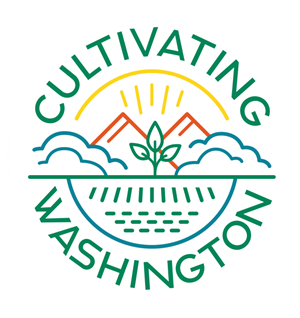On May 1, 1896, local farm families celebrate their completion of the first irrigation ditch carrying Dungeness River water to Sequim Prairie. Located in eastern Clallam County in the rain shadow of the Olympic Mountains, the fertile praire receives less than 17 inches of rain a year. Dug by hand by local farmers who organized the Sequim Prairie Ditch Company in 1895, the ditch marks the beginning of the Sequim Irrigation District. Over the next quarter-century, some 20 ditch companies construct a maze of canals throughout the Dungeness Valley, eventually creating a 25,000-acre canal-sprinkler irrigation system, the largest in Western Washington. The Sequim Irrigation Festival commemorating the opening of the first ditch has been held every year since 1896, making it the oldest continuing festival in the state.
When the first non-Indians settled the Dungeness Valley in the 1850s, they found an extensive open prairie dominated by native Garry oak, a landscape created and maintained by the Klallam inhabitants through carefully managed burning. Its agricultural potential was recognized by the earliest settlers. Visiting from Port Townsend in 1861, James G. Swan (1818-1900), wrote:
"The great fertility of the land in Clallam county, and particularly in the vicinity of Dungeness, is well known" (Swan).
But while other portions of the Olympic Peninsula are noted for record-setting rainfall, Sequim Prairie lies in the rain shadow of the Olympic Mountains and averages under 17 inches per year (less than parts of Eastern Washington). Moreover, most of this rain falls between October and June, so summers are particularly dry and dusty. Early settlers on the prairie raised cattle and did a little farming along creeks and rivers, but intensive agriculture required more water than the sparse rainfall provided.
"Men of Vision"
The Sequim Irrigation District had its origin in a supper get-together in the summer of 1895. D. R. Callen, who had observed irrigation systems in Colorado, convinced three fellow farmers that the fall of the Dungeness River from its Olympic Mountain headwaters provided sufficient force to carry the water up from the river bottom to the dry prairie. They in turn convinced others. While some doubters said water would never run uphill, over 20 "men of vision" (Keeting) organized the the Sequim Prairie Ditch Company in July 1895.
Cash was short. Needing a professional surveyor to file a water rights claim, the company hired Will Ware -- he was so recently graduated that they had to wait to file until he received his credentials, but he agreed to take some of his pay in potatoes.
The ditch company men did most of the construction themselves. They worked through the winter digging the ditch across the prairie, largely with picks and shovels. In the spring they built a square wooden flume to carry the water from the river bottom up to the ditch on the prairie.
On May 1, 1896, all was ready, and pioneer families from around Sequim Prairie gathered for a May Day celebration on the Callen farm next to the waiting ditch. After a festive picnic, ball games, races, and neighborly visiting, the headgate was raised, but at first the river water would not flow into the flume.
"Undaunted, the men located a wagon load of clay and picked up a wagon full of kids. They dumped the clay at the head of the flume in the gravel and told the kids to jump in. The kids got in to the river's edge in their bare feet and tromped the clay into the gravel until the water flowed over it into the flume. It wound its way, the muddy water slowly following the flume, then into the dusty prepared big ditch, and finally all the way to the furrow, right into the picnic area. The skeptics who had said that water couldn't run uphill were at last convinced" ("Festival History").
Farming Flourishes
With the viability of irrigation established, more ditch companies followed. Some 20 were organized by the late 1920s, constructing nine main ditches and and a web of laterals carrying water to individual properties. To spread more water over more land, the irrigators began to use overhead sprinklers fed by pumps in the ditches. Eventually 25,000 acres were irrigated by the largest system west of the Cascades.
The water propelled the growth of a flourishing dairy industry. By 1900 creameries were established at Sequim, Dungeness, and Washington Harbor, which functioned until transportation improvements allowed milk to be processed in Seattle. Produce, seed, and grain production expanded through the first half of the twentieth century. Sequim's landmark grain elevator, the tallest building in the area, was built in 1945 to accomodate the production and operated until 1977 (the building still stands in 2005, housing a restaurant in its base).
A Sequim Irrigation Festival has been held every year since the first celebration, moving into town after several years on the Callen property. May Day festivities with multiple Maypole dances were an important part of early festivals, which also featured polo games, animal acts, clambakes, and other activities. Festival queens have been chosen since 1908, with a more elaborate pageant dating to the 1950s. The festival has grown to a week-long event with parades, carnival, logging show, and many more events, all commemorating the first muddy irrigation water reaching the dusty prairie on May Day, 1896.

